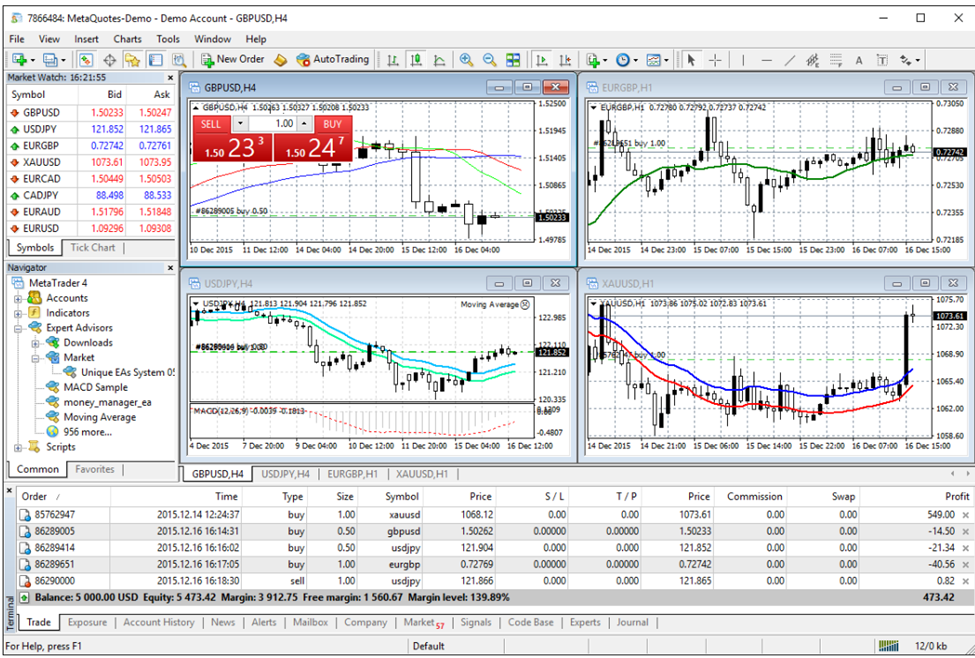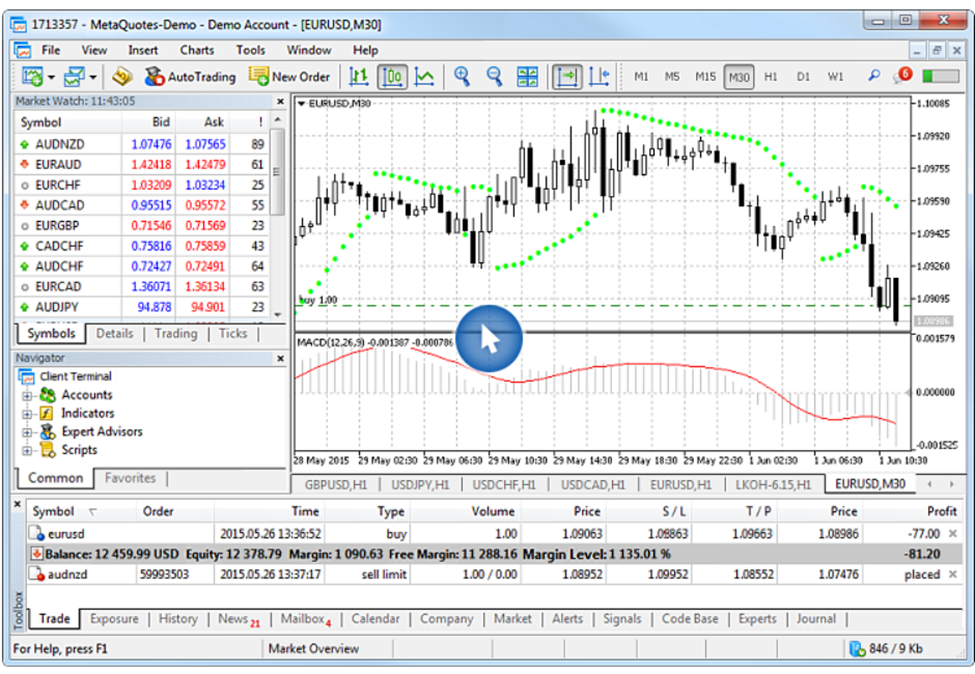
MetaTrader is a popular electronic trading platform used by forex traders. The two main versions, MetaTrader 4 (MT4) and MetaTrader 5 (MT5), offer user-friendly interfaces and advanced charting tools. While MT4, released in 2005, remains widely adopted due to its simplicity and extensive third-party support, MT5, launched in 2010, has gained traction for its advanced features and multi-asset trading capabilities. Both platforms have their advantages and limitations; MT4 has lower system requirements and extensive third-party support, but lacks some advanced features and mainly focuses on forex trading. MT5, on the other hand, supports multiple asset classes and has integrated market depth and economic calendar features, but has a steeper learning curve and less market penetration. This article provides an in-depth comparison of MT4 and MT5 to help traders make an informed decision.
1.1 Background on MetaTrader Platforms
MetaTrader is a series of electronic trading platforms widely used by online forex traders and brokers. Developed by MetaQuotes Software, these platforms have become the industry standard for forex and CFD trading. The two most popular versions of MetaTrader are MetaTrader 4 (MT4) and MetaTrader 5 (MT5). Both platforms offer a user-friendly interface, advanced charting tools, and a range of technical analysis tools to help traders make informed decisions. While MT4 has been the go-to choice for many traders for years, the more recent MT5 has gained traction due to its improved features and capabilities.
1.2 Purpose of the Article
The purpose of this article is to provide an in-depth comparison between MT4 and MT5, highlighting their key features, advantages, and limitations. By examining the differences and similarities between the two platforms, this article aims to help traders make an informed decision on which platform best suits their trading needs and preferences. In addition, the article will offer recommendations for different trader types and provide insights into transitioning between platforms. The information presented in this article is based on the analysis and synthesis of the four referenced articles.
2.1 MT4 Brief History
MetaTrader 4 (MT4) was released in 2005 by MetaQuotes Software, quickly becoming the preferred platform for forex traders and brokers worldwide.

Source: https://www.metatrader4.com/
Its success can be attributed to its user-friendly interface, comprehensive suite of trading tools, and the ability to support automated trading through the use of Expert Advisors (EAs) Over the years, MT4 has undergone several updates, further solidifying its position as the leading forex trading platform.
2.2 Key Features
- User-friendly interface: MT4’s interface is designed to be intuitive and easily navigable, allowing traders to access essential tools and functions quickly.
- Charting and technical analysis tools: MT4 offers an extensive array of charting tools, including multiple chart types, timeframes, and customizable indicators.
- Automated trading: The platform supports the development and implementation of Expert Advisors (EAs), enabling algorithmic and automated trading strategies.
- Customization: Users can customize the platform’s appearance, tools, and indicators to suit their individual trading preferences.
- MQL4 programming language: MT4 uses the MQL4 programming language, allowing developers to create custom indicators, scripts, and EAs.
- Wide broker support: Due to its popularity, most forex brokers offer MT4 as their primary trading platform.
2.3 Advantages and Limitations
Advantages:
- Widely adopted: MT4’s widespread use makes it easy for traders to find resources, tools, and community support.
- Extensive third-party support: There is a vast ecosystem of third-party developers offering custom indicators, EAs, and scripts for MT4.
- Lower system requirements: MT4 has relatively low system requirements, making it accessible to traders using older computers or limited internet bandwidth.
Limitations:
- Limited asset classes: MT4 primarily focuses on forex trading and offers limited support for other asset classes, such as stocks or futures.
- Lacks some advanced features: MT4 lacks some of the more advanced features found in MT5, such as additional order types, the economic calendar, and an integrated depth of market view.
- Incompatibility with MT5: Custom tools, indicators, and EAs developed for MT4 are not directly compatible with MT5, which uses a different programming language (MQL5).
3.1 MT5 Brief History
MetaTrader 5 (MT5) was launched in 2010 as the successor to MT4, with the aim of addressing some of the limitations of its predecessor and offering an enhanced trading experience.

Source: https://www.metatrader5.com/
Despite its initial slow adoption, MT5 has gradually gained popularity among traders and brokers due to its advanced features, support for a wider range of asset classes, and improved performance. Over the years, MetaQuotes has continued to update and refine MT5 to cater to the evolving needs of the trading community.
3.2 Key Features
- Enhanced user interface: MT5 features a more modern and streamlined interface compared to MT4, offering improved navigation and user experience.
- Expanded charting and technical analysis tools: MT5 boasts a larger selection of chart types, timeframes, and technical indicators, providing traders with more comprehensive analysis capabilities.
- Support for additional asset classes: MT5 supports trading in multiple asset classes, including forex, stocks, futures, and commodities, making it suitable for a broader range of traders.
- Advanced order types: MT5 introduces new order types, such as “Buy Stop Limit” and “Sell Stop Limit,” giving traders more flexibility in managing their trades.
- MQL5 programming language: MT5 utilizes the MQL5 programming language, which offers improved performance and expanded functionality compared to MQL4.
- Integrated depth of market and economic calendar: MT5 includes built-in depth of market and economic calendar features, providing traders with valuable real-time information to aid in decision-making.
3.3 Advantages and Limitations
Advantages:
- Multi-asset trading: MT5’s support for various asset classes makes it an attractive option for traders interested in diversifying their portfolios.
- Advanced features: The platform offers several advanced features not found in MT4, such as the economic calendar, integrated depth of market, and additional order types.
- Improved performance: MT5’s enhanced performance and optimization capabilities cater to the needs of high-frequency and professional traders.
- Growing adoption: As more brokers and traders switch to MT5, the platform is likely to benefit from increased third-party support and a growing user community.
Limitations:
- Incompatibility with MT4: Custom tools, indicators, and EAs developed for MT4 are not directly compatible with MT5 due to the different programming languages (MQL4 vs. MQL5).
- Learning curve: Traders accustomed to MT4 may require time to familiarize themselves with MT5’s interface, features, and functionality.
- Lower market penetration: While MT5’s adoption is growing, it has yet to reach the same level of market penetration and third-party support as MT4.
4.1 User Interface and Customization
Both MT4 and MT5 offer user-friendly interfaces with easily accessible tools and functions. However, MT5 features a more modern and streamlined interface compared to MT4, providing improved navigation and user experience. In terms of customization, both platforms allow users to modify the appearance, tools, and indicators to suit their individual preferences. MT5 also introduces detachable charts, enabling traders to arrange their workspace more flexibly across multiple monitors.
4.2 Technical Analysis Tools
MT4 is known for its extensive range of charting tools, including multiple chart types, timeframes, and customizable indicators. However, MT5 expands on these capabilities by offering more chart types, such as Heikin Ashi and Renko, as well as additional timeframes (e.g., 2-minute and 8-hour charts) and a greater selection of built-in technical indicators.

Furthermore, MT5’s analytical tools are more advanced, with features like improved object management and a more comprehensive back-testing environment. Both platforms support the creation of custom indicators and scripts through their respective programming languages, MQL4 for MT4, and MQL5 for MT5.
4.3 Trading Instruments and Timeframes
One of the main differences between MT4 and MT5 is their support for various trading instruments. While MT4 primarily focuses on forex trading, MT5 caters to a broader range of asset classes, including forex, stocks, futures, and commodities. This makes MT5 a more versatile platform for traders who wish to diversify their portfolios and trade across different markets. In addition, MT5 offers a wider range of timeframes, giving traders more granularity and flexibility in their technical analysis and trading strategies.
4.4 Order Execution and Types
Both MT4 and MT5 offer fast and reliable order execution, but MT5 introduces some improvements in terms of order processing and filling mechanisms. MT5 supports four modes of order execution, including Instant Execution, Request Execution, Market Execution, and Exchange Execution, providing traders with greater flexibility in managing their trades. Additionally, MT5 introduces new order types, such as “Buy Stop Limit” and “Sell Stop Limit,” which are not available in MT4. These advanced order types allow traders to have more precise control over their trading strategies and risk management.
4.5 Algorithmic and Automated Trading
Both platforms support algorithmic and automated trading through the use of Expert Advisors (EAs). However, there are some differences in the programming languages used for developing EAs and other custom tools. MT4 uses the MQL4 programming language, while MT5 uses the more advanced MQL5 language. MQL5 offers improved performance and expanded functionality compared to MQL4, making it easier to develop sophisticated EAs and custom indicators. Despite these improvements, it’s important to note that custom tools, indicators, and EAs developed for MT4 are not directly compatible with MT5 due to the differences in programming languages.
4.6 Market Depth and Economic Calendar
MT5 has integrated depth of market (DOM) and economic calendar features, providing traders with valuable real-time information to aid in decision-making. The depth of market feature allows traders to view the number of buy and sell orders at different price levels, offering insights into market liquidity and potential price movements.

The economic calendar displays important economic events and announcements, helping traders stay informed about market-moving events. These features are not available in MT4, which requires users to rely on third-party tools or websites to access similar information.
5.1 Factors to Consider
When choosing between MT4 and MT5, traders should consider the following factors:
- Trading instruments: Determine the types of assets you plan to trade. If you primarily focus on forex trading, MT4 may be sufficient. However, if you wish to trade a diverse range of assets, MT5 offers broader support for various asset classes.
- Custom tools and compatibility: Consider whether you rely on custom indicators, scripts, or EAs developed for MT4, as they are not directly compatible with MT5. If you wish to use MT5, you may need to find or develop new tools compatible with the MQL5 programming language.
- Broker support: Ensure that your preferred broker supports the trading platform you choose. While most forex brokers offer MT4, the availability of MT5 may vary.
- Advanced features: Assess whether you require the advanced features available in MT5, such as the economic calendar, depth of market, or additional order types.
- Technical analysis tools: Consider the importance of advanced charting capabilities, additional timeframes, and a larger selection of built-in indicators in your trading strategies.
- Community and third-party support: Take into account the availability of resources, community support, and third-party tools for each platform.
5.2 Recommendations for Different Trader Types
- Beginner traders: MT4 may be a better choice for beginners due to its widespread use, extensive community support, and lower system requirements. The abundance of educational resources and tutorials makes it easier for new traders to learn the ropes.
- Forex-focused traders: If you primarily trade forex, either platform can be suitable. However, MT4’s popularity in the forex community and its extensive third-party support make it a more convenient choice for many forex traders.
- Advanced and professional traders: MT5’s improved performance, advanced features, and expanded functionality make it a more attractive option for experienced traders and those who require sophisticated trading tools and strategies.
- Multi-asset traders: If you wish to trade various asset classes, MT5 is the better choice, as it supports a wider range of trading instruments, including forex, stocks, futures, and commodities.
- Algorithmic traders: For those focusing on algorithmic and automated trading, MT5 offers an improved programming language (MQL5) and a more comprehensive back-testing environment, making it a more suitable option for developing and implementing complex trading algorithms.
6.1 Challenges and Solutions
Transitioning between MT4 and MT5 may present some challenges for traders, but these can be overcome with adequate planning and resources.
- Incompatibility of custom tools: Custom indicators, scripts, and EAs developed for MT4 are not directly compatible with MT5. To overcome this, traders can either find or develop new tools compatible with the MQL5 programming language or seek assistance from developers experienced in converting MQL4 code to MQL5.
- Learning curve: Traders accustomed to MT4 may require time to familiarize themselves with MT5’s interface, features, and functionality. To minimize the learning curve, traders should make use of available resources, such as tutorials, webinars, and forums, to learn about the new platform’s features and best practices.
- Broker support: Ensure that your preferred broker supports MT5. If your current broker does not offer MT5, consider researching and selecting a reputable broker that provides the platform and meets your trading requirements.
6.2 Tips for a Smooth Transition
- Start with a demo account: Before transitioning to a live trading environment, practice using MT5 with a demo account. This will allow you to become familiar with the platform’s features and functions without risking real capital.
- Learn from the community: Engage with the MT5 community through forums and social media groups to learn tips, tricks, and best practices from experienced users.
- Seek technical support: If you encounter technical issues or require assistance with custom tools, consider reaching out to the MetaQuotes support team or experienced MQL5 developers for guidance.
- Gradual transition: Consider transitioning your trading strategies and tools from MT4 to MT5 gradually, rather than making a sudden switch. This will allow you to identify and resolve potential issues in a controlled manner.
- Keep abreast of updates: Stay informed about the latest updates and improvements to MT5 by following MetaQuotes’ announcements and engaging with the user community. This will help you make the most of the platform’s evolving features and capabilities.
7.1 Key Takeaways
- MT4 and MT5 are both powerful trading platforms developed by MetaQuotes Software, with MT4 primarily focusing on forex trading and MT5 supporting a wider range of asset classes.
- Both platforms offer user-friendly interfaces, comprehensive technical analysis tools, and support for algorithmic trading. However, MT5 introduces advanced features, such as the economic calendar, depth of market, and additional order types.
- The choice between MT4 and MT5 depends on the trader’s individual needs, preferences, and trading instruments. Factors to consider include broker support, required trading tools, and the availability of custom tools compatible with each platform.
- Transitioning between platforms may present challenges, but these can be overcome with adequate planning, learning resources, and community support. A smooth transition can be facilitated by starting with a demo account, engaging with the user community, and gradually implementing changes.
7.2 Future Developments and Updates
As the trading landscape continues to evolve, it is expected that MetaQuotes will introduce further updates and improvements to both MT4 and MT5 platforms. However, given the focus on MT5 as the successor to MT4, it is likely that more advanced features and enhancements will be introduced for MT5 in the future. Traders should stay informed about the latest developments and updates to make the most of the platforms’ capabilities and adapt to the changing needs of the market. Additionally, as MT5 adoption grows among brokers and traders, the platform may gradually gain market share and third-party support, eventually surpassing MT4 as the industry standard for forex and multi-asset trading.
Read More




